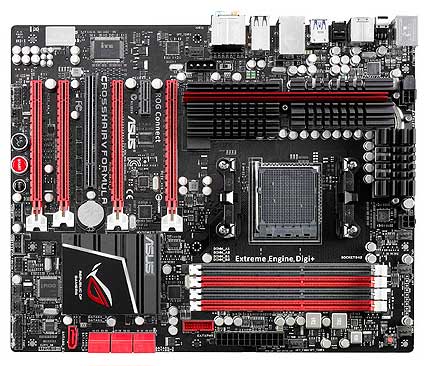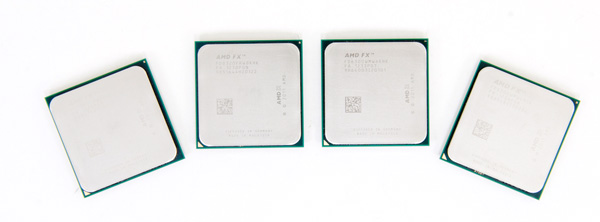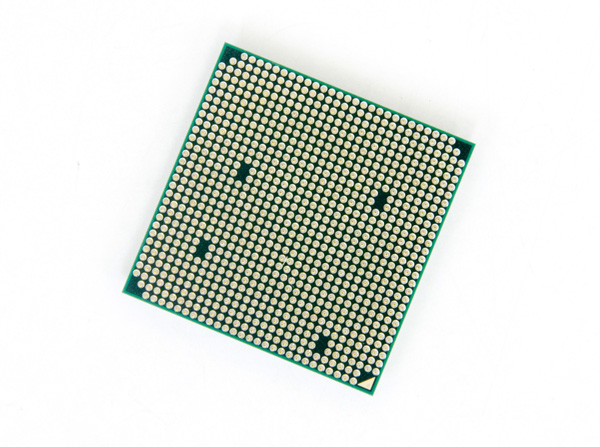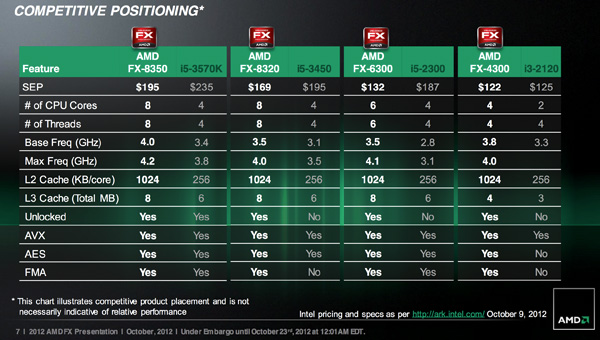The Vishera Review: AMD FX-8350, FX-8320, FX-6300 and FX-4300 Tested
by Anand Lal Shimpi on October 23, 2012 12:00 AM ESTLast year's launch of AMD's FX processors was honestly disappointing. The Bulldozer CPU cores that were bundled into each Zambezi chip were hardly power efficient and in many areas couldn't significantly outperform AMD's previous generation platform. Look beyond the direct AMD comparison and the situation looked even worse. In our conclusion to last year's FX-8150 review I wrote the following:
"Single threaded performance is my biggest concern, and compared to Sandy Bridge there's a good 40-50% advantage the i5 2500K enjoys over the FX-8150. My hope is that future derivatives of the FX processor (perhaps based on Piledriver) will boast much more aggressive Turbo Core frequencies, which would do wonders at eating into that advantage."
The performance advantage that Intel enjoyed at the time was beyond what could be erased by a single generation. To make matters worse, before AMD could rev Bulldozer, Intel already began shipping Ivy Bridge - a part that not only increased performance but decreased power consumption as well. It's been a rough road for AMD over these past few years, but you have to give credit where it's due: we haven't seen AMD executing this consistently in quite a while. As promised we've now had multiple generations of each platform ship from AMD. Brazos had a mild update, Llano paved the way for Trinity which is now shipping, and around a year after Zambezi's launch we have Vishera: the Piledriver based AMD FX successor.
At a high level, Vishera swaps out the Bulldozer cores from Zambezi and replaces them with Piledriver. This is the same CPU core that is used in Trinity, but it's optimized for a very different purpose here in Vishera. While Trinity had to worry about working nicely in a laptop, Vishera is strictly a high-end desktop/workstation part. There's no on-die graphics for starters. Clock speeds and TDPs are also up compared to Trinity.
| CPU Specification Comparison | ||||||||
| CPU | Manufacturing Process | Cores | Transistor Count | Die Size | ||||
| AMD Vishera 8C | 32nm | 8 | 1.2B | 315mm2 | ||||
| AMD Zambezi 8C | 32nm | 8 | 1.2B | 315mm2 | ||||
| Intel Ivy Bridge 4C | 22nm | 4 | 1.4B | 160mm2 | ||||
| Intel Sandy Bridge E (6C) | 32nm | 6 | 2.27B | 435mm2 | ||||
| Intel Sandy Bridge E (4C) | 32nm | 4 | 1.27B | 294mm2 | ||||
| Intel Sandy Bridge 4C | 32nm | 4 | 1.16B | 216mm2 | ||||
| Intel Lynnfield 4C | 45nm | 4 | 774M | 296mm2 | ||||
| Intel Sandy Bridge 2C (GT1) | 32nm | 2 | 504M | 131mm2 | ||||
| Intel Sandy Bridge 2C (GT2) | 32nm | 2 | 624M | 149mm2 | ||||
Vishera is still built on the same 32nm GlobalFoundries SOI process as Zambezi, which means there isn't much room for additional architectural complexity without ballooning die area, and not a whole lot of hope for significantly decreasing power consumption. As a fabless semiconductor manufacturer, AMD is now at GF's mercy when it comes to moving process technology forward. It simply has to make 32nm work for now. Piledriver is a light evolution over Bulldozer, so there's actually no substantial increase in die area compared to the previous generation. Cache sizes remain the same as well, which keeps everything roughly the same. These chips are obviously much larger than Intel's 22nm Ivy Bridge parts, but Intel has a full node advantage there which enables that.
Piledriver is a bit more power efficient than Bulldozer, which enables AMD to drive Vishera's frequency up while remaining in the same thermal envelope as Zambezi. The new lineup is in the table below:
| CPU Specification Comparison | ||||||||||
| Processor | Codename | Cores | Clock Speed | Max Turbo | L2/L3 Cache | TDP | Price | |||
| AMD FX-8350 | Vishera | 8 | 4.0GHz | 4.2GHz | 8MB/8MB | 125W | $199 | |||
| AMD FX-8150 | Zambezi | 8 | 3.6GHz | 4.2GHz | 8MB/8MB | 125W | $183 | |||
| AMD FX-8320 | Vishera | 8 | 3.5GHz | 4.0GHz | 8MB/8MB | 125W | $169 | |||
| AMD FX-8120 | Zambezi | 8 | 3.1GHz | 4.0GHz | 8MB/8MB | 125W | $153 | |||
| AMD FX-6300 | Vishera | 6 | 3.5GHz | 4.1GHz | 6MB/8MB | 95W | $132 | |||
| AMD FX-6100 | Zambezi | 6 | 3.3GHz | 3.9GHz | 6MB/8MB | 95W | $112 | |||
| AMD FX-4300 | Vishera | 4 | 3.8GHz | 4.0GHz | 4MB/4MB | 95W | $122 | |||
| AMD FX-4100 | Zambezi | 4 | 3.6GHz | 3.8GHz | 4MB/4MB | 95W | $101 | |||
The table above says it all. TDPs haven't changed, cache sizes haven't changed and neither have core counts. Across the board Vishera ships at higher base frequencies than the equivalent Zambezi part, but without increasing max turbo frequency (in the case of the 8-core parts). The 6 and 4 core versions get boosts to both sides, without increasing TDP. In our Trinity notebook review I called the new CPU core Bulldozed Tuned. The table above supports that characterization.
It's also important to note that AMD's pricing this time around is far more sensible. While the FX-8150 debuted at $245, the 8350 drops that price to $199 putting it around $40 less than the Core i5 3570K. The chart below shows where AMD expects all of these CPUs to do battle:
AMD's targets are similar to what they were last time: Intel's Core i5 and below. All of the FX processors remain unlocked and ship fully featured with hardware AES acceleration enabled. Most Socket-AM3+ motherboards on the market today should support the new parts with nothing more than a BIOS update. In fact, I used the same ASUS Crosshair V Formula motherboard I used last year (with a much newer BIOS) for today's review:

The Test
For more comparisons be sure to check out our performance database: Bench.
| Motherboard: | ASUS Maximus V Gene (Intel Z77) ASUS Crosshair V Formula (AMD 990FX) |
| Hard Disk: | Intel X25-M SSD (80GB) Crucial RealSSD C300 OCZ Agility 3 (240GB) Samsung SSD 830 (512GB) |
| Memory: | 4 x 4GB G.Skill Ripjaws X DDR3-1600 9-9-9-20 |
| Video Card: | ATI Radeon HD 5870 (Windows 7) NVIDIA GeForce GTX 680 (Windows 8) |
| Desktop Resolution: | 1920 x 1200 |
| OS: | Windows 7 x64/Windows 8 Pro x64 |













250 Comments
View All Comments
A5 - Tuesday, October 23, 2012 - link
The gaming benchmarks contain exactly 0 FPS games. You should really read the article before commenting.kevith - Tuesday, October 23, 2012 - link
I could eat a dictionary and SHIT a better comment than that.CeriseCogburn - Tuesday, October 30, 2012 - link
" The FX-8350 did immensely better in that gaming selection. Mostl gamers are not shoot-em-up fascist gamers. "LOL - wrong again, but your lefty whine was extremely amusing. Most gamers are shoot em up gamers, YOU LIAR.
GullLars - Tuesday, October 23, 2012 - link
What they didn't show you is what happens when you OC the K parts from intel. They end up roughly in the same TDP as AMD on stock, and just crush them on performance, so if you are going to use the same aftermarket cooler and will overclock either pick, the Intel parts can go further and win across the board.Compared to the cost of an entire system ~$100-150 extra on the CPU for a 3770K might end up being around a 10% increase in total build cost, and giving you anywhere from 10 to 50% better performance (or more in some corner cases).
I'm happy with my OC'd 3930K :D (compared to to the rest of my equipment, the price was no problem)
Probably upgrading my C2D 2.0GHz + 8600GTM laptop to a Haswell with only IGP in 2013. With an SSD and RAM upgrade it has had surprisingly good longevity.
CeriseCogburn - Tuesday, October 30, 2012 - link
Exactly, all the amd cpu unlockers, all the dang phenom 2 overlcockers - totally silent.The 2500K smoke sit up to 4500mhz like butter, but heck, when something is freaking GREAT and it's not in amd's advantage, it's memory hole time, it's ignore it completely after barely mentioning it, and just as often continue to declare it an unused and unliked and proprietary failure that holds everyone back - whatever can be done to lie and skew and spin.
It's just amazing isn't it.
eanazag - Tuesday, October 23, 2012 - link
I had pretty low expectations admittedly and for good reason. This is a great step because I would have to think platform vs. platform where before I didn't even need to consider it. Intel has a huge thermal advantage, which indicates that Intel could easily come out with a proc at anytime to take advantage of that headroom should AMD ever become slightly threatening, and sadly still be below performance per Watt. I could reasonably consider AMD now for my desktop. Where AMD fails is at the platform level. They have underperformed in the motherboard department. If they wanted to sell more, they need to give serious advantages at the motherboard + CPU purchase level versus Intel. They have been fine with a mediocre chipset. They failed when they locked out Nvidia from chipset development, same with Intel. AMD and Intel's greed was a big loss for the consumer and part of the reason why AMD doesn't compete well with Intel. Nvidia made better chipsets for AMD than AMDs ATI chipset development team.It is even worse on the server side for AMD. AMD needs to include 10GbE on the board to really question Intel and this is doable. AMD cannot compete on process (22nm and 3D transistors) unless Intel closed shop for 18 months.
CeriseCogburn - Tuesday, October 30, 2012 - link
LOL - thank you so much.Yes, the hatred for nVidia (and Intel) cost the amd fanboys dearly, but they really, really, really enjoyed it when nVidia chipsets got shut down.
nVidia was going to be destroyed then shortly thereafter according to them, and thus we heard a couple years of it from their freaking pieholes - amd would drop the price and knife nVidia into oblivion... and bankrupcty... cause amd has a "lot more room" to price drop and still rake in profit... they said... LOL - as they whined about nVidia being greedy and making so much money.
Yes, they were, and are, nutso.
Oh the party days they had... now they have CRAP. LOL
Ken g6 - Tuesday, October 23, 2012 - link
Anand, I think you missed a diamond in the rough here for gaming. Obviously, if someone has the money for an i5, they should get an i5. But if they don't, the FX-4300 looks like a better gaming choice than an i3. There are cheap mobos available, so overall cost is less than an i3, and the FX-4300 is overclockable. OCed it may even approach low-end i5 performance - at a power cost, of course.tekphnx - Tuesday, October 23, 2012 - link
For only $10 more I'd say the FX-6300 is the better bet. Slightly lower clock speed but still overclockable, and I don't think it will be that long before six cores become really relevant for gaming.lmcd - Tuesday, October 23, 2012 - link
Worst case you can probably disable a core and OC more, right?